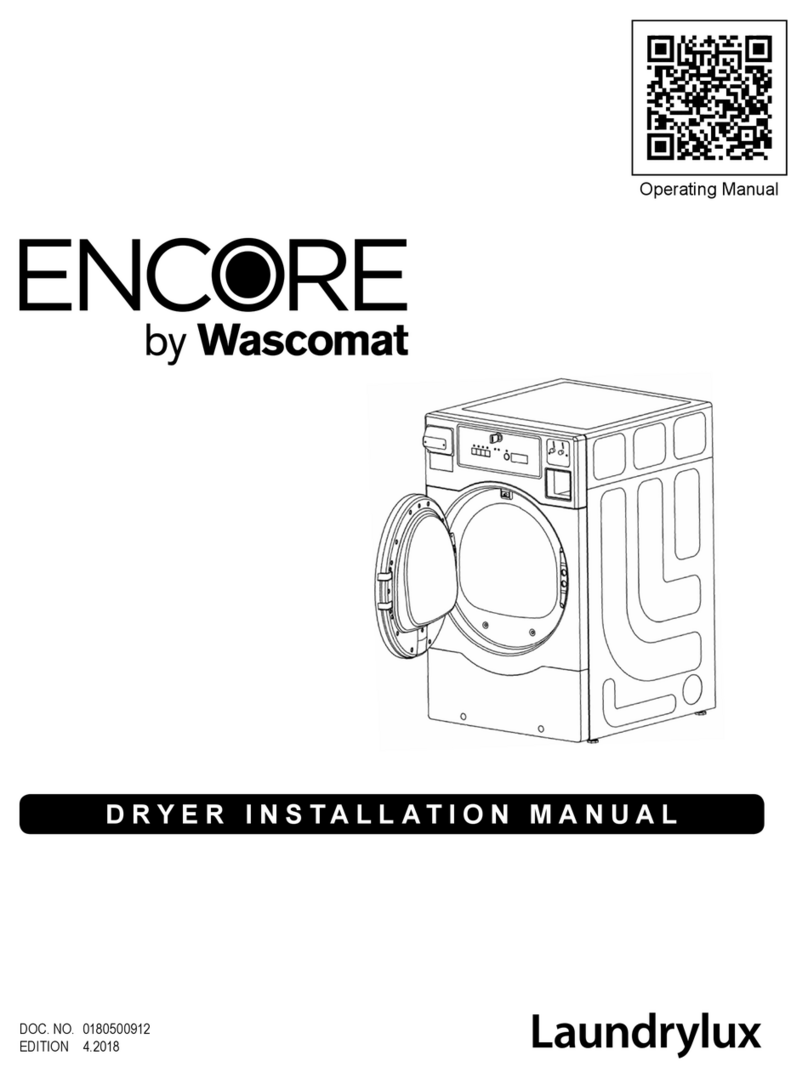
4112819-1
Safety Precautions ___________________
!WARNING
For your safety, the information in this manual must
be followed to minimize the risk of fire or explosion
and to prevent property damage, personal injury, or
loss of life.
The dryer must never be operated with any of the
ba k guards, outer tops, or servi e panels removed.
Personal injury or fire ould result.
Failure to properly install, maintain, and/or operate
dryer a ording to this manual and operator’s
manuals in luded with dryer may result in onditions,
whi h an ause serious injury, death and/or property
damage.
Do not store or use gasoline or other flammable vapors and
liquids in the vicinity of this or any other appliance.
Do not spray aerosols in the vicinity of this appliance while it
is in operation.
Purchaser and user should consult the local gas supplier for
proper instructions to be followed in the event the user smells
gas. The instructions should be posted in a prominent
location.
What To Do If You Smell Gas:
• Do not try to light any appliance.
• Do not touch any electrical switch.
• Do not use any phone in your building.
• Clear the room, building, or area of all occupants.
• Immediately call your gas supplier from a neighbor’s
phone. Follow the gas supplier’s instructions.
• If you cannot reach your gas supplier, call the fire
department.
Installation and service must be performed by a qualified
installer, service agency, or gas supplier.
Dryers must be exhausted to the outdoors.
Although the manufacturer produces a very versatile dryer,
there are some articles that, due to fabric composition or
cleaning method, should not be dried in it.
!WARNING
Dry only water washed fabri s. Do not dry arti les
spotted or washed in dry leaning solvents,
ombustible detergents, or “all purpose” leaner.
Explosion ould result.
Do not dry rags or arti les oated or ontaminated
with gasoline, kerosene, oil, paint, or wax. Explosion
ould result.
Items that have been spotted or soaked with
vegetable or ooking oil onstitute a fire hazard and
should not be pla ed in a tumble dryer.
Do not dry mop heads. Contamination by wax or
flammable solvents will reate a fire hazard.
!WARNING
Do not use heat for drying arti les that ontain plasti ,
foam, sponge rubber, or similarly textured rubber
materials. Drying in a heated tumbler may damage
plasti s or rubber and also may be a fire hazard.
A program should be established for the inspection and
cleaning of lint in the burner area, exhaust ductwork, and area
around the back of the dryer. The frequency of inspection
and cleaning can best be determined from experience at each
location.
!WARNING
The olle tion of lint in the burner area and exhaust
du twork an reate a potential fire hazard.
For personal safety, the dryer must be electrically grounded
in accordance with local and/or country codes. In the absence
of these codes use the National Electrical Code ANSI/NFPA
NO. 70-LATEST EDITION or in Canada, the Canadian
Electrical Codes Parts 1 & 2 CSA C22.1-1990 or LATEST
EDITION.
NOTE: Failure to electrically ground the dryer properly will
void the warranty.
!WARNING
Personal injury or fire ould result should the dryer
door swit h, lint door/drawer, or heat safety ir uit
ever be disabled.
Remove articles from the dryer as soon as the drying cycle
has been completed.
!WARNING
Arti les left in the dryer after the drying and ooling
y les have been ompleted an reate a fire hazard.
For safety, proper operation, and optimum performance, the
dryer must not be operated with a load less than 66% of its
rated capacity.
!WARNING
You must dis onne t and lo kout the ele tri supply
and the gas supply or the steam supply before any
overs or guards are removed from the ma hine to
allow a ess for leaning, adjusting, installation, or
testing of any equipment per OSHA standards.
IMPORTANT: The dryer must be installed in a location/
environment, which the ambient temperature remains
between 40° F (4.44° C) and 130° F (54.44° C).
The operation of this appliance may affect the operation of
other types of gas appliances, which take their air for safe
combustion from the same room. If in doubt, consult the
appliance manufacturer(s).
































